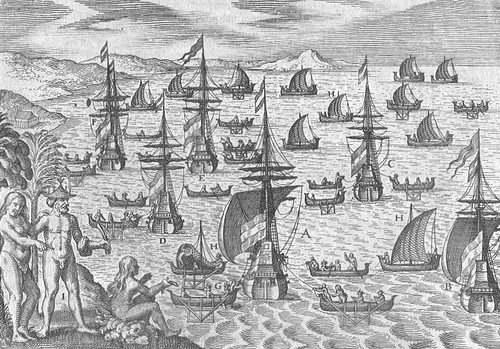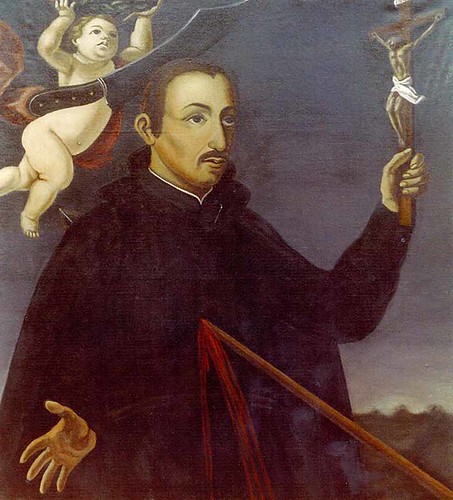Matå’pang: Matapang
Killed Padre San Vitores
History will remember Maga’låhi Matå’pang from Tomhom (Tumon) as the man responsible for murdering Father Diego Luís de San Vitores, the Spanish Jesuit priest who brought Christianity to the Mariana Islands. Matå’pang’s significance, however, has changed over the centuries as Chamorro/CHamorus and their understanding of historical events has changed.
Because the Spanish once considered him an evil savage, the CHamoru word matå’pang, which used to mean to cleanse is now used to describe someone as silly or something as tasteless. In recent history, however, perceptions of Matå’pang’s story has evolved, and the chief has re-gained recognition as a CHamoru hero for resisting colonial rule. A beach close to where Matå’pang killed San Vitores in Tumon Bay is called Matå’pang Beach to this day.
Rejected Christianity
At first a Christian convert, Matå’pang eventually rejected Christianity, along with many other CHamorus, because he saw that it was being used as a tool to control his people and obliterate CHamoru traditions and beliefs.
Since he had already been baptized and was thought to have been cured from an illness by San Vitores, the Spanish hoped to bring Matå’pang back to the church. San Vitores used the birth of Matå’pang’s daughter to approach the Tomhom leader. On 2 April 1672, San Vitores, along with Pedro Calangsod (also spelled Calangsor), a man who had served with the priest for four years, entered Matå’pang’s home without permission with the intention of baptizing his daughter.
Matå’pang was infuriated by their actions, particularly because it was thought by many CHamorus that the baptismal water was poisonous. The priests were said to have spit in the water, and many of the children and elderly who had been baptized died shortly after. Matå’pang was also upset that the priests had disregarded the sacredness of entering a maga’låhi’s home. He had grown tired of San Vitores’ continuous disrespect for CHamoru traditions and beliefs. Since his arrival, San Vitores conducted daily baptisms on children without their parents’ permission.
Upon learning of the baptism of his daughter, Matå’pang and another man named Hirao immediately went after San Vitores. As San Vitores and Calangsod fell at their hands, San Vitores did not attempt to protect himself, instead praying for his slayers.
Matå’pang weighted the bodies and tossed them into the sea and set a fire where the stabbings had taken place. Matå’pang then joined other leaders who were fighting the Spanish and led his people in many battles. The Spanish noted that Matå’pang “was a person of great strength, notwithstanding his age.”
Prior to San Vitores’ death, the Spanish had been on a Christianizing mission. Following the murder, however, Christianizing the CHamorus became a military endeavor and the CHamoru rebellion intensified. Captain Juan de Santiago was sent to Guam in search of vengeance for the priest’s death by burning village houses and canoes to prevent the CHamorus from escaping. Matå’pang got into a skirmish with Santiago’s men and was wounded. He fled to the island of Luta (Rota) to recover from his injury.
In 1680, military Governor Jose de Quiroga was sent to the Marianas to quash the CHamoru rebellion. An attack fleet was initially sent to Rota where Matå’pang was living. The violent threat of Quiroga led island leaders on Rota to turn on Matå’pang. They stabbed him and put him in a boat. Matå’pang died on the way back to Guam. His body was thrown into the waters off Hagåtña and his head was brought to the Spanish.
By Victoria-Lola Leon Guerrero, MFA and Nicholas Yamashita Quinata
For further reading
Benavente, Ed L.G. I Manmañaina-ta: I Manmaga’låhi yan I Manmå’gas; Geran Chamoru yan Españot (1668-1695). Self-published, 2007.
de Morales, Luis, and Charles Le Gobien. History of the Mariana Islands. Mangilao: University of Guam Press, 2016.
Hezel, Francis X., SJ. “From Conversion to Conquest: The Early Spanish Mission in the Marianas.” The Journal of Pacific History 17, no. 3 (1982): 115-37.
I Manfåyi: Who’s Who in Chamorro History. Vol. 1. The Hale’-ta Series. Hagåtña: Political Status Education and Coordinating Commission, 1995.
Lévesque, Rodrigue. History of Micronesia: A Collection of Source Documents. Vols. 1-13. Québec: Lévesque Publications, 1992-1998.
Risco, Alberto, SJ. The Apostle of the Marianas: The Life, Labors, and Martyrdom of Ven. Diego Luis de San Vitores, 1627-1672. Translated by Juan M.H. Ledesma, SJ and edited by Msgr. Oscar L. Calvo. Hagåtña: Diocese of Agana, 1970.
Rogers, Robert. Destiny’s Landfall: A History of Guam. Honolulu: University of Hawai`i Press, 1995.


